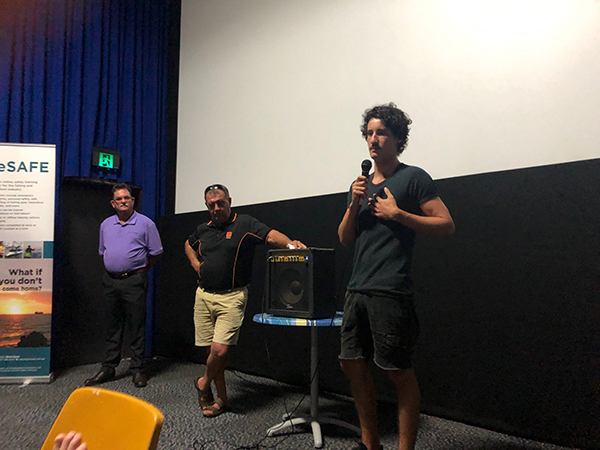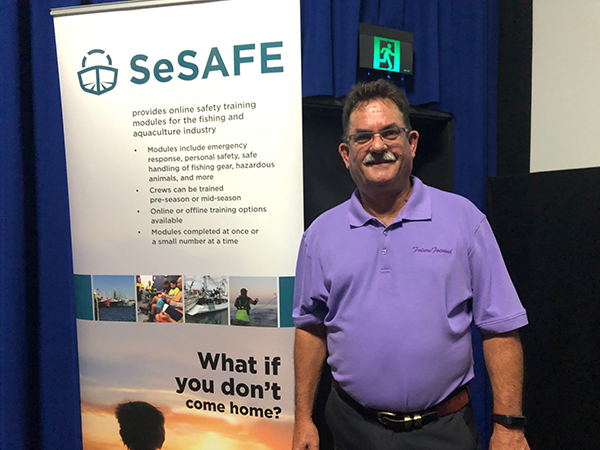The seafood industry’s safety initiative, SeSAFE (featuring an award-winning film about the sinking of the ‘Sea Rogue’ 12 years ago) launched at the Yamba Cinema on Thursday February 27.
Special guests invited to the launch included Clarence Valley’s mayor Jim Simmons, Sea Rogue deckhands Michael Williams (who swam to shore to raise the alarm) and John (JJ) Jarrett (who did not attend for personal reasons); family members of Charlie Picton (who tragically lost his life), Stuart Richey AM Chairman Australian Maritime Safety Authority and the filmmaker Matt Blyth.
The launch was “a collaboration between the SeSAFE project team and Millstream Productions”, a Fisheries Research and Development Corporation (FRDC) media release says.
“The film captures the story of the loss of the FV Sea Rogue off [Byron Bay] in 2008; whereby deckhand Michael Williams swam 15 nautical miles to shore in an attempt to raise help and save the crews’ lives.”
“It’s a co-funded project with Austral Fisheries, the Australian Maritime Safety Authority and FRDC.
“Project SeSAFE has two objectives; primarily the project aims to provide on-line workplace safety learning systems for crew and companies.
“Secondly the project promotes conversation about the value of workplace safety within the seafood industry, and the promotion of a positive safety culture.”
John Harrison, who is currently the executive chairman of the FRDC’s Seafood Industry Safety Initiative program, was the Clarence Professional Fishermen’s Association’s executive officer when the Sea Rogue was lost in 2008.
“We’re looking at research, development and extension opportunities in the seafood industry to keep our people safe,” he said.
“The nine-minute video clip, ‘Sea Rogue’, will be used as a training video for safety at sea in the SeSAFE project.”
Matt Blyth said: “The motivation behind making this film was to make fishermen aware of how important safety is.
“I was on a prawn trawler recently and a young guy said to me, ‘safety is no accident’.
“He was spot on; if you’ve got a safety management system and you are acting on it then these terrible events don’t happen.
“When you have something like this happen, you want to do something.
“The film has taken out some big awards, which is a tribute to Mick [Williams].
“I want to say again, ‘thanks Mick for sharing the story’.
At the launch, Mark Picton, Charlie’s brother, said: “Charlie was lost just shy of his 40th birthday.
“It only seems fitting that a bloke of Charlie’s nature would be the skipper of a boat named Sea Rogue.
“I’m hoping that this short film opens up some minds on how we are going forward in this industry, and how we can keep our fishermen safe at sea.
“My list of thankyous starts with Mick, thank you for your survival skills for being able to bring … Charlie’s story back from the depths of the ocean.
“And, as we all know, if you had decided to stay with Charlie and Jay Jay on that morning I can guarantee there would be three names on that plaque and your daughter would not exist.
“After 12 years I finally get to meet you and thank you in person.”
Fisher and chair of the Australian Maritime Safety Authority, Stuart Richie, said: “I’ve gotta say that the Picton family have inspired me that they want the story told so that we can actually learn from the experience, to protect other people.
“I think all parents in this room would know what it’s like when your son is at sea, if it was yourself you wouldn’t be worried, but seeing as it’s your family you do like to worry.
“We have to do a lot of work improving our safety culture, there is no upside to being regarded as one of the most dangerous industries in Australia and it’s gotta be the new generation of fishers who’ll bring about the biggest change in safety culture in our industry.
“It’s up to us to provide them with the best information, and the best safety tools, to bring about that culture change.”


